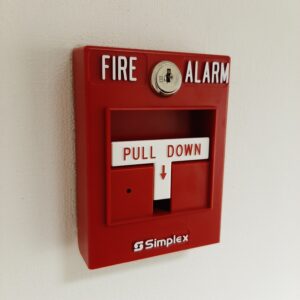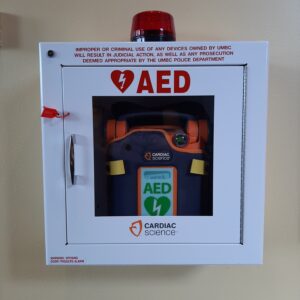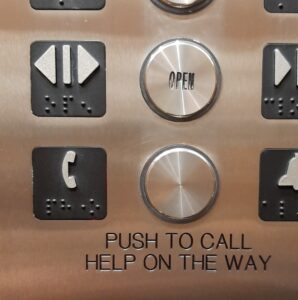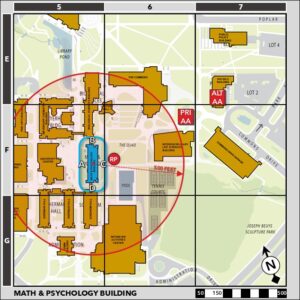The emergency action plans below include information about preparedness, evacuations, and shelter-in-place.
Go to our Active Assailant Awareness webpage to learn about lockdowns and actions you can take to survive an attack on or off campus.
Preparedness
Click on the menus below for information about this facility, emergency exits, fire alarms, medical emergencies, and elevator emergencies.
Facility Profile
- Facility Name, Building Number, and Abbreviation: Math and Psychology Building, #0860, “MP”
- Access and Hours of Operation: UMBC Police manually unlock all exterior entrances at this building Monday through Friday by 6:00 AM. Unless instructed to lock earlier or later, Police lock this building by 11:00 PM. Outside these hours, entry requires physical key access. Saturday through Sunday, if a department needs the building open for a special event, they may request UMBC Police open the building before and close immediately afterwards. There are no exterior entrances with swipe-card access.
- Facility Managers (shared responsibility): Cael Mulcahy (CAHSS), E-mail: cmulcahy@umbc.edu, Office Phone: (410) 455-2960, and Dennis Cuddy (CNMS), E-mail: cuddy@umbc.edu, Office Phone: (410) 455-2544
- Primary Occupants: Department of Psychology, College of Arts, Humanities, and Social Sciences (CAHSS), and Department of Mathematics and Statistics, College of Natural and Mathematical Sciences (CNMS)
- Occupied Floors and Departments: 6 levels (ground, first – fourth, and penthouse)
Ground Level Departments
First Level Departments
Second Level Departments
Third Level Departments
Fourth Level Departments
Emergency Exits

Exterior emergency exits are located on the Lower (Ground), First, and Fourth* Levels.
- Use the closest emergency exit on your floor.
- During a fire alarm, use stairs. DO NOT USE ELEVATORS.
- Use the closest ground floor emergency exit to evacuate the building.
- Emergency exits may have a local alarm that activates when the door is opened.
*NOTE: Bridges on the Fourth Level of the Math and Psychology Building connect to:
- Biological Sciences Building via Bridge 4BR1, adjacent to Elevator 1 and Stair 1 on the north end of the building.
- Sondheim Hall via Bridge 4BR2, adjacent to Elevator 2 and Stair 2 on the south end of the building.
- If you cannot safely access this building’s exterior emergency exits, these connecting exits can be used for evacuation to the adjoining buildings.
- Use the closest exterior emergency exit in the adjoining building and evacuate to your Rally Point.
Fire Alarms

Manual pull station locations are marked on your building’s emergency exit maps using this symbol.
- These are locations where occupants can manually activate fire alarms.
- Manual pull stations are normally located near entrances to stairs and at all emergency exits

Fire alarm DOs and DON’Ts:
- DO pull the alarm if you see or smell smoke or see fire.
- DO NOT pull the alarm for a security threat like an active assailant, bomb threat, or suspicious package (refer to our Emergency Management Response Guides for more information).
- DO evacuate immediately to your rally point. Call UMBC Police at (410) 455-5555 after you are safe.
- DO NOT try to fight a fire. Only individuals trained in the use of fire extinguishers should do so.
How do fire alarms operate at this building?
- If you pull a fire alarm on any floor, alarms will activate in all areas on all floors.
- All occupants on all floors are required to evacuate.
Medical Emergencies

Automated External Defibrillator (AED) locations are marked on your building’s posted emergency exit maps using this symbol.
- Use an AED to help an unconscious person who is not breathing and experiencing sudden cardiac arrest.

Look for this sign to locate an AED. Device locations at this building:
- Third Level: In the corridor outside room 301.
- Go to https://safety.umbc.edu/aed/ for more information.

No special training is necessary. Anyone can use an AED.
- Pull open the cabinet door to break the red plastic tab security tab. An alarm will sound and UMBC Police will be automatically notified.
- Call UMBC Police at (410) 455-5555 and your emergency will be relayed to 911.
- Take the AED to the emergency site, open the device, and follow the prompts.

Steps of an AED rescue:
- Open the lid and the AED will start working. There is no power button to press.
- The AED provides voice and text prompts to guide you through a rescue.
- It will recognize each action you take and will ensure you complete every critical task before moving on.
- Remain on the line with the Police operator. Follow instructions to help stabilize the emergency until an ambulance arrives.
- Continue first-aid or CPR until relieved by first responders.
Elevator Emergencies

Elevators ARE present in this building.
- Elevator Entrapment. All elevators have an emergency call button which rings directly to UMBC Police.
- UMBC Police will call Facilities Management Work Control and will notify the fire department.
- UMBC Police will also respond to any elevator emergency situation.
Evacuations
Click on the menus below for information about this facility’s evacuation rally point and assembly areas, and any special instructions for occupants. Use this link to review our Emergency Action Procedures for building evacuation.
Evacuation Map
Know where to go after evacuating. Click on the map for a larger view.
- Confirm emergency conditions exist INSIDE your building. Err on the side of caution to protect occupants.
- Evacuate immediately when you hear the fire alarm. Use the closest emergency exit on your floor.
- Use stairs, DO NOT USE ELEVATORS. Use the closest ground floor emergency exit to evacuate the building.
- Once you are safe, call UMBC Police at (410) 455-5555. UMBC Police will relay your emergency to 911.
- Go to your rally point (RP) and remain outside the 50-foot blue perimeter on the map.
- If UMBC Police give the all-clear, you may leave your rally point and reenter the building.
Evacuate your rally point immediately and go to your primary assembly area (PRI AA) if:
- There are obvious signs of danger, like smoke or fire, or…
- UMBC Police verify there is an actual threat and they direct you to evacuate your rally point.
Rally Point
RALLY POINT LOCATION: Southwest corner of The Quad, near the outdoor pool.

Your rally point is marked on the map using this symbol.
You must evacuate for any fire alarm on your floor. Though false alarms are possible, we will always respond as if the threat is real.
- If there are no obvious signs of danger, like smoke or fire, go to your rally point to ensure your safety while UMBC Police verify the emergency.
- Go to your rally point and remain outside the 50-foot blue perimeter on the map.
- If UMBC Police give the all-clear, you may leave your rally point and reenter the building.
Leaders have three objectives at the rally point:
- Take accountability of your people.
- Confirm the nature of the alarm with UMBC Police.
- Determine if there is an actual threat to occupant safety.
Evacuate your rally point immediately and go to your primary assembly area if:
- There are obvious signs of danger, like smoke or fire, or…
- UMBC Police verify there is an actual threat and they direct you to evacuate your rally point.
Assembly Areas
PRIMARY ASSEMBLY AREA LOCATION: Between the Interdisciplinary Life Sciences Building (ILSB) and the Public Policy Building.

Your primary assembly area is marked on the map using this symbol.
- If there is a confirmed threat, evacuate your rally point and go to your primary assembly area.
- Be aware of traffic. DO NOT walk into the path of moving vehicles when crossing streets.
- Remain outside the 500-foot red perimeter at all times. Do not reenter the building until UMBC Police give the all-clear.
ALTERNATE ASSEMBLY AREA LOCATION: Physics Building, First Level.

Your alternate assembly area is marked on the map using this symbol.
- Go to your alternate assembly area ONLY IF DIRECTED or if there is an obvious safety or security threat at the primary assembly area.
- Alternate assembly areas are indoor or covered spaces that provide some protection from inclement weather and other outdoor concerns.
Shelter-In-Place
Click on the menus below for information about this facility’s interior shelter areas for environmental hazards areas, and any special instructions for occupants.
Interior Shelter Areas
INTERIOR SHELTER AREAS: Interior corridors, interior stairwells, and internal spaces on the ground level and first level.
Internal Shelter Area map – coming soon
Know where to go for shelter from environmental hazards. Click on the map for a larger view.
- Confirm emergency conditions exist OUTSIDE your building. Err on the side of caution to protect occupants.
- DO NOT PULL THE FIRE ALARMOR EVACUATE if there is no fire or other threat inside the facility.
- Take accountability of your people.
- Stay away from external windows and doors. Do not leave your shelter area until UMBC Police give the all-clear.
A shelter-in-place order may take two forms:
- SHELTER ACTION: This action may require you to move to your floor’s indoor shelter areas.
- INTERNAL RELOCATION: This action may require you to move to a different floor or area of your building. You may use stairs or elevators unless directed not to do so.
Know the difference between SHELTER-IN-PLACE and LOCKDOWN.
- SHELTER-IN-PLACE: An order issued for environmental hazards outside your building such as severe weather or hazardous materials accident.
- LOCKDOWN: An order issued for a security threat, like an active assailant. This action is meant to prevent an armed intruder from entering your building, your classroom, workplace, or living space. For more information, review our Lock Down and Safe Haven Guidelines – September 2023
